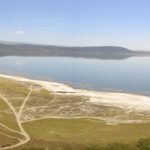New research published this week in Nature Communications, has shown how African springs helped to shape human evolution.
A unique combination of groundwater and agent based modelling has revealed insight into the importance of spring water in human evolution across East Africa.
By mapping springs and other water sources across the African landscape researchers have been able to model how our ancestors may have moved between water sources taking into account the energetic cost of the landscape.
More importantly, by modelling these springs through a simulated climate cycle they have shown how the springs were vital to human survival in the most arid of times. Springs acted as key hydro-refugia for our ancestors, a term first coined by one of the authors Tom Gleeson (University of Victoria).
As climate became drier the spring and water network became sparse and in reverse, during wet times, they became denser allowing widespread movement. Understanding this pattern of mobility and its variation with both climate and geological conditions would have impacted on the mixing of genes within our ancestral populations.
Groundwater currently provides nearly a third of the world’s population with drinking water. It is used for irrigation to produce the largest share of the world’s food supply and is a vital commodity, but this research shows that it may have also shaped our evolutionary history.
Mark Cuthbert (Cardiff University) who led the inter-disciplinary team that did the research said, “We found that the geology is really important in controlling how much rainfall gets stored in the ground during wet periods. Modelling the springs showed that many could still flow during long dry periods because this groundwater store acts like a buffer against climate change”.
Matthew Bennett (Bournemouth University) said, “What we are seeing is the movement of people across vast areas of land. You can think of springs as the service stations or rest stops along the way, where people would be drawn to get their vital water sources. Through our mapping we have found the routes on the current landscape by which our ancestors may have walked, like motorways, taking people from one water source to the next. This is another vital clue in understanding how these people migrated across the African continent, from water source to source, and how this may have impacted on gene flow and mixing.”
This explains the dispersal of people we have seen, as networks of springs have facilitated migration. We are able to see that there were geological reasons for migration, not just climate related reasons. The landscape was a catalyst for change in Africa.
The research was conducted by a collaborative team of academics from the Cardiff University, University of Birmingham, University College London, UNSW Australia, Bournemouth University, Rutgers University (USA) and the University of Victoria (Canada).
 How prehistoric water pit stops may have driven human evolution
How prehistoric water pit stops may have driven human evolution










 Dr. Ashraf cited on ‘Modest Fashion’ in The Guardian
Dr. Ashraf cited on ‘Modest Fashion’ in The Guardian NIHR-funded research launches website
NIHR-funded research launches website Academics write for newspaper in Nepal
Academics write for newspaper in Nepal New paper published on disability in women & girls
New paper published on disability in women & girls MSCA Postdoctoral Fellowships 2025 Call
MSCA Postdoctoral Fellowships 2025 Call ERC Advanced Grant 2025 Webinar
ERC Advanced Grant 2025 Webinar Horizon Europe Work Programme 2025 Published
Horizon Europe Work Programme 2025 Published Horizon Europe 2025 Work Programme pre-Published
Horizon Europe 2025 Work Programme pre-Published Update on UKRO services
Update on UKRO services European research project exploring use of ‘virtual twins’ to better manage metabolic associated fatty liver disease
European research project exploring use of ‘virtual twins’ to better manage metabolic associated fatty liver disease